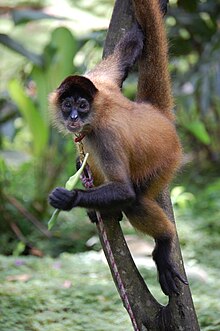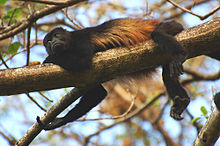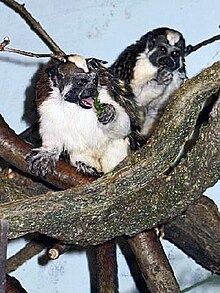User:Rlendog/Sandbox3
<--Reywas92 suggestions for List of Central American Monkey species at User:Reywas92/List of Central American monkey species-->

At least seven monkey species are native to Central America. An eighth species, the Coiba Island Howler (Alouatta coibensis) is often recognized, but some authors treat it as a subspecies of the Mantled Howler, (A. palliata).[1] A ninth species, the Black-headed Spider Monkey is also often recognized, but some authorities regard it as a subspecies of Geoffroy's Spider Monkey.[2] Taxonomically, all Central American monkey species are classified as New World monkeys, and they belong to four families. Five species belong to the family Atelidae, which includes the howler monkeys, spider monkeys, woolly monkeys and muriquis. Two species belong to the family Cebidae, the family that includes the capuchin monkeys and squirrel monkeys. One species each belongs to the night monkey family, Aotidae, and the tamarin and marmoset family, Callitrichidae.
Geoffroy's Spider Monkey (Ateles geoffroyi) is the only monkey found in all seven Central American countries, and it is also found in Colombia, Ecuador and Mexico.[3][1] Other species that have a widespread distribution throughout Central America are the Mantled Howler (Alouatta palliata), which is found in five Central American countries, and the White-headed Capuchin (Cebus capucinus), which is found in four Central American countries.[4][5] The Coiba Island Howler, the Black-headed Spider Monkey (Ateles fusciceps), the Panamanian Night Monkey (Aotus zonalis) and Geoffroy's Tamarin (Saguinus geoffroyi) are each found in only one Central American country, Panama.[6][7][8][9] The Central American Squirrel Monkey (Saimiri oerstedii) also has a restricted distribution, living only on part of the Pacific coast of Costa Rica and a small portion of Panama.[10] El Salvador is the Central American country with the fewest monkey species, as only Geoffroy's Spider Monkey lives there. Panama has the most species, eight, as the only Central American monkey species that does not include Panama within its range is the Guatemalan Black Howler (Alouatta pigra).

Geoffroy's Tamarin is the smallest Central American monkey, with an average size of about 0.5 kilograms (1.1 lb).[11] The Central American Squirrel Monkey and Panamanian Night Monkey are almost as small, with average sizes of less than 1.0 kilogram (2.2 lb).[12][13] The Guatemalan Black Howler has the largest males, which average over 11.0 kilograms (24.3 lb), and the spider monkey species have the largest females, averaging over 8.0 kilograms (17.6 lb).[14][15]
One Central American monkey, the Black-headed Spider Monkey, is considered to be critically endangered by the International Union for Conservation of Nature (IUCN).[7] Geoffroy's Spider Monkey and the Guatemalan Black Howler are both considered to be endangered.[3][16] The Central American Squirrel Monkey had been considered endangered, but its conservation status was upgraded to vulnerable in 2008.[10] The Coiba Island Howler is also considered to be vulnerable.[6] The White-headed Capuchin, the Mantled Howler and Geoffroy's Tamarin are all considered to be of least concern from a conservation standpoint.[5][4][9]
Geoffroy's Tamarin also has a fairly wide range within Panama, from west of the Panama Canal to the Colombian border.[7] The range of the Black-headed Spider Monkey within Panama is limited to the eastern portion of the country near the Colombian border.[8] The Central American Squirrel Monkey only occurs within Panama in the extreme western portion of the country, near Costa Rica.[9] Its now has a smaller range within Panama than in the past, and is no longer found in its type locality, the city of David.[9] As its name suggests, the Coiba Island Howler is restricted to Coiba Island.[10] The Azuero Howler Monkey (Alouatta coibensis trabeata or Alouatta palliata trabeata), which is considered a subspecies of either the Coiba Island Howler or the Mantled Howler, is restricted to the Azuero Peninsula.[3] Each of the four Costa Rican species can be seen in national parks within Costa Rica, where viewing them in natural surroundings is a popular tourist attraction.[5][6] The only park in which all four species can be seen is Corcovado National Park, on the Osa Peninsula.[7] The Central American Squirrel Monkey is most often seen in Manuel Antonio National Park and Corcovado National Park in Costa Rica.[11] Both the White-headed Capuchin and the Mantled Howler are commonly seen in Costa Rica's parks.[18][12]
Central American monkey species
[edit]



Footnotes
[edit]- a Sometimes regarded as a subspecies of Alouatta palliata.[6] Sizes given are for Alouatta palliata.
- b Sometimes regarded as a subspecies of Aotus lemurinus, in which case its trinomial name is Aotus lemurinus zonalis.[21]
- c Sometimes regarded as a subspecies of Ateles geoffroyi.[2]
References
[edit]- ^ a b Rylands, A., Groves, C., Mittermeier, R., Cortes-Ortiz, L. & Hines, J. (2006). "Taxonomy and Distributions of Mesoamerican Primates". New Perspectives in the Study of Mesoamerican Primates. Springer. pp. 29–80. ISBN 0-387-25854-X.
{{cite book}}: Unknown parameter|editors=ignored (|editor=suggested) (help)CS1 maint: multiple names: authors list (link) - ^ a b Collins, A. (2008). "The taxonomic status of spider monkeys in the twenty-first century". In Campbell, C. (ed.). Spider Monkeys. Cambridge University Press. p. 50–67. ISBN 978-0-521-86750-4.
- ^ a b c "Ateles geoffroyi". IUCN Red List of Threatened Species. 2008. 2008.
{{cite journal}}: Unknown parameter|assessors=ignored (help); Unknown parameter|downloaded=ignored (help) {{cite iucn}}: error: no identifier (help) - ^ a b c "Alouatta palliata". IUCN Red List of Threatened Species. 2008. 2008.
{{cite journal}}: Unknown parameter|assessors=ignored (help); Unknown parameter|downloaded=ignored (help) {{cite iucn}}: error: no identifier (help) - ^ a b c "Cebus capucinus". IUCN Red List of Threatened Species. 2008. 2008.
{{cite journal}}: Unknown parameter|assessors=ignored (help); Unknown parameter|downloaded=ignored (help) {{cite iucn}}: error: no identifier (help) - ^ a b c d "Alouatta palliata ssp. coibensis". IUCN Red List of Threatened Species. 2008. 2008.
{{cite journal}}: Unknown parameter|assessors=ignored (help); Unknown parameter|downloaded=ignored (help) {{cite iucn}}: error: no identifier (help) - ^ a b c "Ateles fusciceps". IUCN Red List of Threatened Species. 2008. 2008.
{{cite journal}}: Unknown parameter|assessors=ignored (help); Unknown parameter|downloaded=ignored (help) {{cite iucn}}: error: no identifier (help) - ^ a b "Aotus zonalis". IUCN Red List of Threatened Species. 2008. 2008.
{{cite journal}}: Unknown parameter|assessors=ignored (help); Unknown parameter|downloaded=ignored (help) {{cite iucn}}: error: no identifier (help) - ^ a b c "Saguinus geoffroyi". IUCN Red List of Threatened Species. 2008. 2008.
{{cite journal}}: Unknown parameter|assessors=ignored (help); Unknown parameter|downloaded=ignored (help) {{cite iucn}}: error: no identifier (help) - ^ a b c "Saimiri oerstedii". IUCN Red List of Threatened Species. 2008. 2008.
{{cite journal}}: Unknown parameter|assessors=ignored (help); Unknown parameter|downloaded=ignored (help) {{cite iucn}}: error: no identifier (help) - ^ a b Defler, T. (2004). Primates of Colombia. Conservation International. pp. 163–169. ISBN 1-881-17383-6.
- ^ a b c Jack, K. (2007). "The Cebines". In Campbell, C., Fuentes, A., MacKinnon, K., Panger, M., & Bearder, S. (ed.). Primates in Perspective. The Oxford University Press. pp. 107–120. ISBN 978-0-19-517133-4.
{{cite book}}: CS1 maint: multiple names: editors list (link) - ^ a b Fernandez-Duque, E. (2007). "Aotinae". In Campbell, C., Fuentes, A., MacKinnon, K., Panger, M., & Bearder, S. (ed.). Primates in Perspective. The Oxford University Press. pp. 139–154. ISBN 978-0-19-517133-4.
{{cite book}}: CS1 maint: multiple names: editors list (link) - ^ a b c d e Di Fiore, A. and Campbell, C. (2007). "The Atelines". In Campbell, C., Fuentes, A., MacKinnon, K., Panger, M., & Bearder, S. (ed.). Primates in Perspective. The Oxford University Press. pp. 155–177. ISBN 978-0-19-517133-4.
{{cite book}}: CS1 maint: multiple names: authors list (link) - ^ a b Rowe, N. (1996). The Pictorial Guide to the Living Mammals. Pogonias Press. p. 113. ISBN 0-9648825-0-7.
- ^ a b "Alouatta pigra". IUCN Red List of Threatened Species. 2008. 2008.
{{cite journal}}: Unknown parameter|assessors=ignored (help); Unknown parameter|downloaded=ignored (help) {{cite iucn}}: error: no identifier (help) - ^ Wilson, et al. Mammal Species of the World (2005)
- ^ Groves, C. P. (2005). Wilson, D. E.; Reeder, D. M. (eds.). Mammal Species of the World: A Taxonomic and Geographic Reference (3rd ed.). Baltimore: Johns Hopkins University Press. pp. 148–149. ISBN 0-801-88221-4. OCLC 62265494.
- ^ Groves, C. P. (2005). Wilson, D. E.; Reeder, D. M. (eds.). Mammal Species of the World: A Taxonomic and Geographic Reference (3rd ed.). Baltimore: Johns Hopkins University Press. p. 149. ISBN 0-801-88221-4. OCLC 62265494.
- ^ Groves, C. P. (2005). Wilson, D. E.; Reeder, D. M. (eds.). Mammal Species of the World: A Taxonomic and Geographic Reference (3rd ed.). Baltimore: Johns Hopkins University Press. p. 149. ISBN 0-801-88221-4. OCLC 62265494.
- ^ a b Groves, C. P. (2005). Wilson, D. E.; Reeder, D. M. (eds.). Mammal Species of the World: A Taxonomic and Geographic Reference (3rd ed.). Baltimore: Johns Hopkins University Press. p. 140. ISBN 0-801-88221-4. OCLC 62265494.
- ^ Groves, C. P. (2005). Wilson, D. E.; Reeder, D. M. (eds.). Mammal Species of the World: A Taxonomic and Geographic Reference (3rd ed.). Baltimore: Johns Hopkins University Press. p. 150. ISBN 0-801-88221-4. OCLC 62265494.
- ^ Groves, C. P. (2005). Wilson, D. E.; Reeder, D. M. (eds.). Mammal Species of the World: A Taxonomic and Geographic Reference (3rd ed.). Baltimore: Johns Hopkins University Press. pp. 150–151. ISBN 0-801-88221-4. OCLC 62265494.
- ^ Groves, C. P. (2005). Wilson, D. E.; Reeder, D. M. (eds.). Mammal Species of the World: A Taxonomic and Geographic Reference (3rd ed.). Baltimore: Johns Hopkins University Press. p. 137. ISBN 0-801-88221-4. OCLC 62265494.
- ^ Groves, C. P. (2005). Wilson, D. E.; Reeder, D. M. (eds.). Mammal Species of the World: A Taxonomic and Geographic Reference (3rd ed.). Baltimore: Johns Hopkins University Press. ISBN 0-801-88221-4. OCLC 62265494.
- ^ Groves, C. P. (2005). Wilson, D. E.; Reeder, D. M. (eds.). Mammal Species of the World: A Taxonomic and Geographic Reference (3rd ed.). Baltimore: Johns Hopkins University Press. pp. 138–139. ISBN 0-801-88221-4. OCLC 62265494.
See also
[edit][[Category:Regional mammals lists|Central America]] [[Category:Fauna of Central America|Mammals]] [[Category:New World monkeys]]
